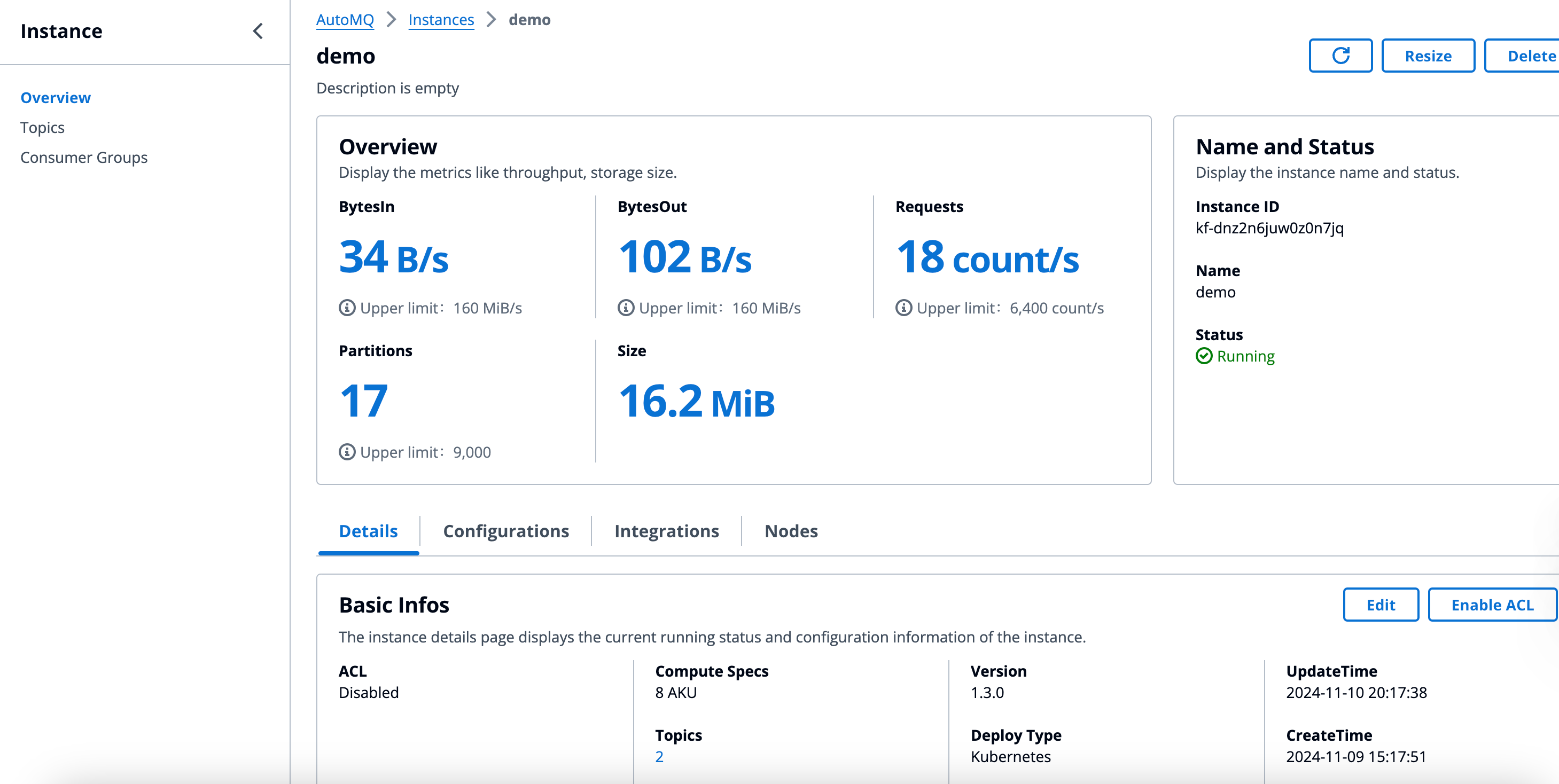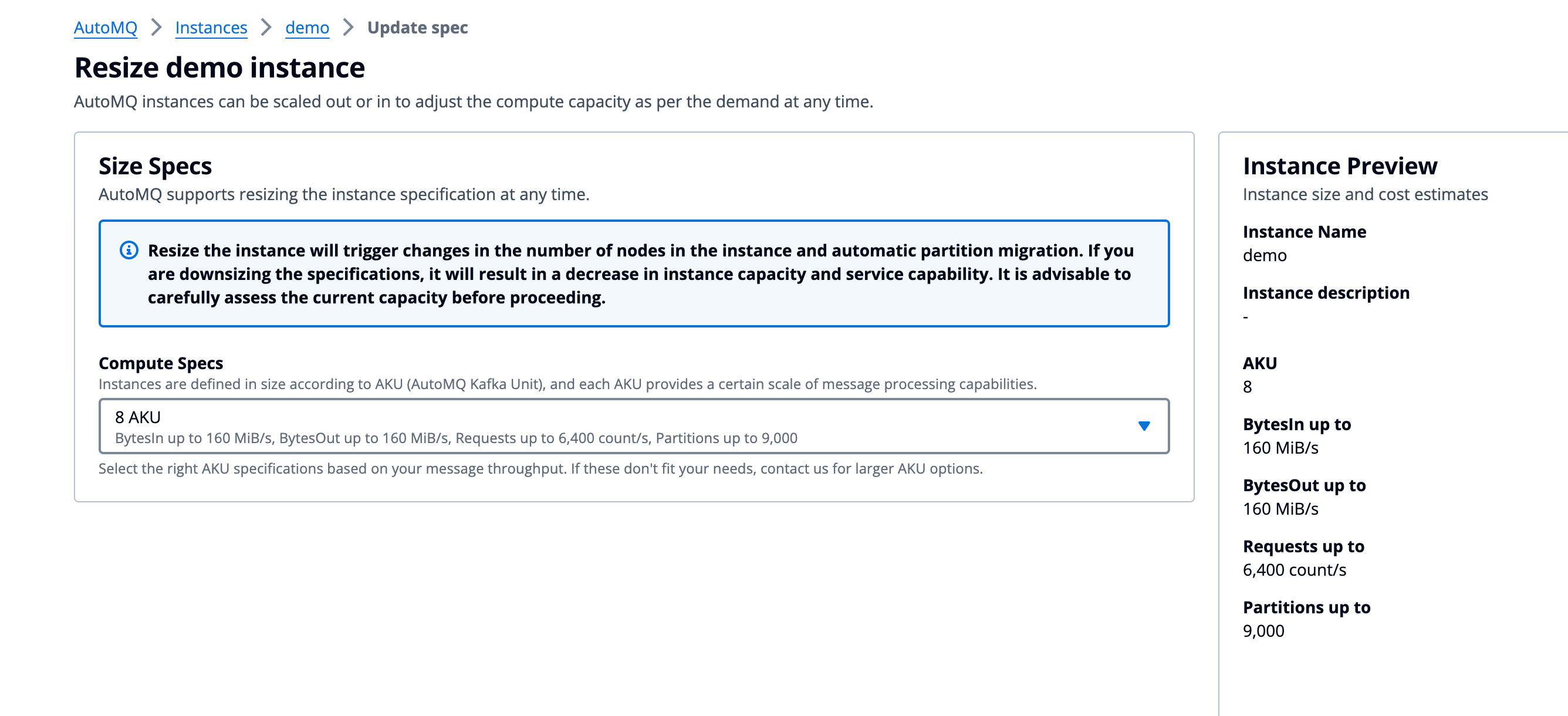Manage Instances
This article introduces the basic concepts of instances, related constraints, and operations for creating, viewing, modifying, and deleting instances.
Instance
Basic Concepts
An instance is the top-level operational resource of the AutoMQ for Kafka product. A Kafka instance corresponds to an independent cluster of Apache Kafka®.
Lifecycle
The complete lifecycle of an instance, from creation to release, is illustrated in the following diagram:

Creating: The initial instance creation operation is an asynchronous process. When the creation operation is completed, the instance is deployed asynchronously in the background. During this process, users cannot make any changes until the creation is finished.
Running: The current instance is in an active running state, capable of providing all messaging functions and API services normally.
In Progress: The current instance is undergoing maintenance, version upgrades, or other operations. Since these processes are asynchronous, changes must wait for completion. During this period, any modifications to the instance are prohibited.
Service Exception: The current instance cannot provide normal service due to execution of creation, maintenance changes, or underlying infrastructure anomalies.
Deleting: The current instance is being manually deleted and released. Instances in the process of deletion will no longer accept services, and resources and data will be cleaned up asynchronously in the background.
Deleted: The current instance has been manually deleted and released. Once released, the instance cannot be recovered.
Create Instance
Steps
To experience AutoMQ Kafka message sending and receiving, you first need to create a Kafka instance.
Log in to the environment console and click on the instance list in the left navigation bar.
On the instance list page, click "Create Instance." In the popup instance creation page, add the configuration with the following information.
| Parameter | Description |
|---|---|
| Instance Name |
|
| Instance Remarks |
|
| Zone Information |
|
| Subnet Information |
|
| Compute Specifications |
|
| Storage Specifications |
|
| Node Type (Advanced Options) |
When using annual/monthly subscription ECS, AutoMQ will enable automatic renewal by default to prevent the unavailability of instances due to expiration. When using annual/monthly subscription ECS, during scaling down or deletion of AutoMQ instances, there may be ECS instances pending for recycling. Users need to manually cancel and recycle these instances in the cloud provider console to avoid continuous charges. |
- After selecting the appropriate parameters, click confirm to create the instance.
View Instance
Steps
Navigate to the Instance List page.
Locate the instance that needs to be updated from the list, and click on the instance name.
On the Instance Details page, view the instance details information.

Instance Scaling
Steps
Navigate to the Instance List page.
Locate the instance that needs to be updated from the list, and click on the instance name.
On the Instance Details page, click the Reconfigure button, adjust the instance's compute specifications as needed, and click Confirm to complete the modifications.

Instance Version Upgrade
Instance Version
AutoMQ BYOC environment, instance version management refers to Release Notes▸.
To upgrade the instance version, you must first ensure the environment console is at the correct version. Otherwise, complete the console upgrade first. For upgrading the environment console, refer to Upgrade Environment Version▸.
Steps
Navigate to the Instance List page.
Locate the instance that needs to be updated from the list, and click on the instance name.
On the Instance Details page, review the current instance version and the recommended upgrade version. Click the Upgrade button, confirm the new version, and proceed with the rolling upgrade.
During the AutoMQ instance upgrade, a rolling upgrade strategy is used to apply changes in batches, ensuring no disruption to message sending and receiving.
Deleting an Instance
Deleting an instance refers to the process of removing an instance that is no longer needed, thus releasing the underlying resources.
Steps
Navigate to the Instance List page.
Locate the instance that needs to be updated in the instance list, then click the action button dropdown on the right.
Find the delete button, click delete, and confirm the deletion in the secondary confirmation prompt to complete the operation.